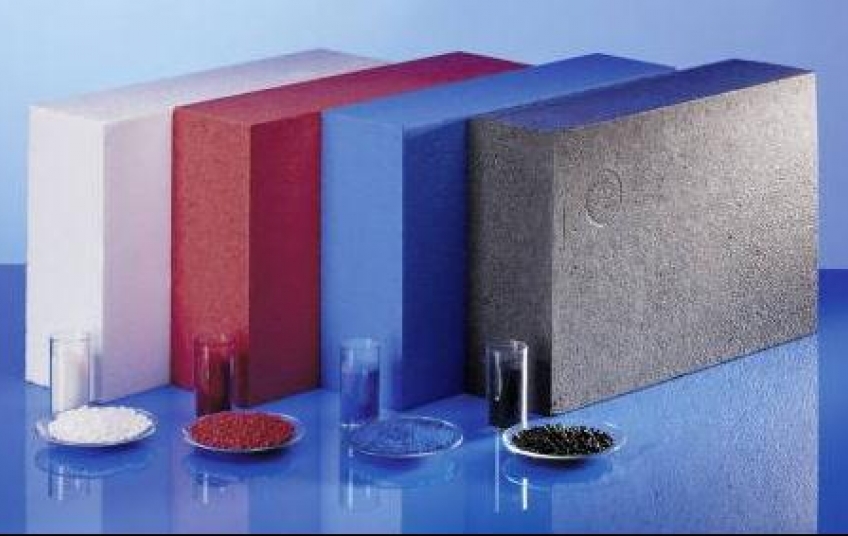Expanding plastics into low-density cellular foam requires introduction of a fine network of gas bubbles, or cells, in to the plastic’s mass. Processes that involve cell initiation, growth, and stabilization prepare most expandable plastics. The main factors in the formation are differential pressures for the cell growth and the surrounding medium. By controlling the quantity of blowing agent, the temperature, and other production factors, expanded plastics can be produced having different densities. Expanded polystyrene (EPS), expanded polyethylene and polyurethane (PUR) are the bulk of expanded plastics used.
One formulation method is allowing the pressure within a cell to increase to the surroundings. This is referred to as expandable processes where chemical and physical characteristics are utilized to stabilize the plastic. In most cases, the desired shape is formed by heating the plastic in the presence of a blowing agent (isometric pentanes or hexanes) and it becomes entrapped. Then, the expandable plastic is carried out in a two-step process. First, by utilizing steam, hot water, or hot air, replicas of the original material can be formed. Once aged, these replicas are placed in a mold and exposed to steam. Then, the filled mold is ready for the second expansion, which is the most critical, integral step. The material is able to flow and fuse which results in a molded piece. The article is then cooled and the density can be adjusted. Polyurethane is produced by a chemical reaction and can be expanded by gases formed during said reaction. PU foams can be made into very soft resilient foams, or stiff hard foams.
Another method is to extrude the expanded sheet in an annular die, similar to blown film extrusion. The blowing agent is introduced in the extruder and expands in the plastic sheet as it leaves the extruder. The tube is slit in half and rolled up for further conditioning. Expanded polystyrene (EPS) is made in a single screw extruder under pressure, or in an injection molding machine treated with a blowing agent as previously described.
Polyurethane (PUR) has been around for over 60 plus years in the United States alone, and other countries. It is mainly used for cushioning material, high performance adhesives, and insulation panels. These materials are light weight, good absorbency durability, and have good dampening properties. Some published data from 2007 showed that the global consumption of polyurethane raw materials was above 12 million metric tons, the average annual growth rate is about 5%. Revenues generated with PUR on the global market are expected to rise to approximately $80 billion (US) by 2020.
Expanded polystyrene (EPS) was first introduced in the early 1940s with the trade name of Styrofoam. It is commonly used in three areas: insulation in housing, retrofitting in old buildings, and insulation in mobile homes. EPS foam sheets are utilized in packaging materials such as disposable dishes, egg cartons, food containers, and drinking cups. There are some restrictions of EPS packaging (food) in certain parts of the US and Korea due to littering, storm drain issues, and landfill issues. However, there are some good sustainability aspects of EPS. It is non-toxic and completely inert. The reuse of this non-renewable product could be for new building products, light weight fillers, or energy recovery.
In summary, the entire range of expanded plastics could be from rigid to flexible. Low cost, ease of fabrication, consumer appeal, and great barrier properties make it useful and desirable for various applications. It is amazing how certain expanded plastics affect daily lives in some shape, form or fashion. It could be from packaging fragile items, insulating our homes to improve energy consumption, putting a smile on a kids faces with a toy, or packaging our favorite foods for consumption.

Expanded polyestrene is also commonly used for packaging
References
Pennakem, LLC, Research and Development Department G. Avar, Polyurethanes (PU), Kunststoffe international 10/2008, 123-127.
http://www.prnewswire.com/news-releases/polyurethane-dispersions-market-by-type-by-application---trends--forecasts-to-2020-300194153.html
Mark, Bikales, Overberger, Menges, Encyclopedia of Polymer Science and Engineering, Volume 3 (2nd editions) pages 5-66.
Verghese, Lewis, and Fitzpatrick, Packaging for Sustainability, pages 157, 166, 226, 264, 349, and 356
Fundamentals of Packaging Technology, 5th ed., Ch11, Institute of Packaging Professionals


































